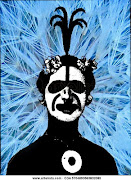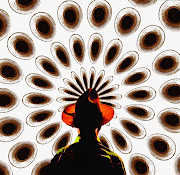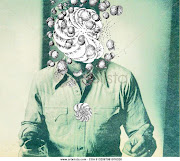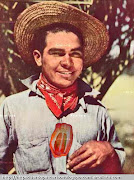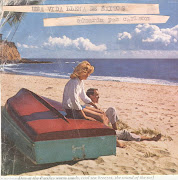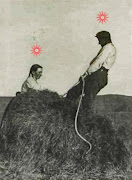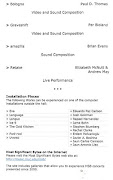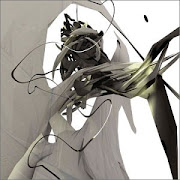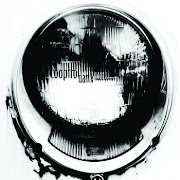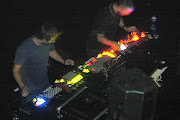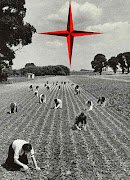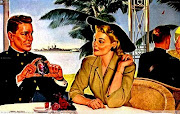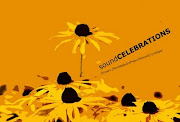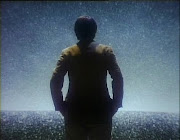domingo, 31 de julio de 2016
poema "6" parte"Desechos de Cuerpo 2", del libro "CUERPO"
Etiquetas:
cuerpo,
Eduardo Paz Carlson,
poesia uruguaya
sábado, 30 de julio de 2016
Nostalgia - Filme Completo sub BR EN ESP FRA DE
Nostalghia(1983)/ Andrei Tarkovsky / BWV853
A Message to Young People from Andrei Tarkovsky
jueves, 28 de julio de 2016
"Mejor Luz" , poema del libro "Tierra Luminosa" de epc, 1985-86, publicado en 1993 en mvdeo
Etiquetas:
poesia uruguaya,
tierra luminosa
martes, 26 de julio de 2016
collage digital HEROE 48 2, en artelista
Etiquetas:
artelista,
collage,
Eduardo Paz Carlson
lunes, 25 de julio de 2016
EXCLU interview C.Vander- MAGMA in New-York City !
Interview - Christian Vander - Magma
MAGMA - Hhaï / Zombies Live Triton 2005
sábado, 23 de julio de 2016
Born With Stripes (full album) - The Donkeys
Pyongyong ...Poema a mi perro Ney, 1976, del libro Bordes del Limbo (1979)
Etiquetas:
marginal,
ni leida,
poesía uruguaya,
siglo XX,
underground,
vanguardia
Daughter of Stanley Kubrick Speaks Out
viernes, 22 de julio de 2016
collage sin titulo m55 2011, por epc
collage sin titulo 22 julio 2016 , por epc
jueves, 21 de julio de 2016
Poema sin titulo de Poemplastiks 1 por epc
miércoles, 20 de julio de 2016
domingo, 17 de julio de 2016
Poema del libro wiriwiri, 1979 por epc
Etiquetas:
1979,
Eduardo Paz Carlson,
poema,
poesia uruguaya,
wiri wiri,
wiriwiri
sábado, 16 de julio de 2016
THE HOMECOMING, NEWELL CONVERS WYETH (1882-1945)
Etiquetas:
NEWELL CONVERS WYETH,
THE HOMECOMING
el nacimiento de eva 1
Etiquetas:
collage,
eva,
surrelismo. surrealistas. belleza
jueves, 14 de julio de 2016
la criatura grafitera en artelista, old collage by epc, 2002
Etiquetas:
collage,
Eduardo Paz Carlson
Primer borrador de "el café de las tribus urbanas",1987,epc
Etiquetas:
artículo,
diapop,
Eduardo Paz Carlson,
el día
Borrador de poema del libro tierra luminosa, 1985,epc
Etiquetas:
Eduardo Paz Carlson,
luminosa,
poesia,
tierra
MissAlice_94 pureza total y libertad
@MissAlice_94: https://twitter.com/MissAlice_94/status/753423397762150401?s=09
https://twitter.com/MissAlice_94/status/753423397762150401
miércoles, 13 de julio de 2016
#23Ways you could be killed if you're black in America:
We joined with @aliciakeys, @Beyonce & more to shed light on #23Ways you could be killed if you're black in America:https://t.co/LO5ujy3jw3— Mic (@mic) July 13, 2016
We joined with @aliciakeys, @Beyonce & more to shed light on #23Ways you could be killed if you're black in America:https://t.co/LO5ujy3jw3— Mic (@mic) July 13, 2016
Etiquetas:
america,
black,
black lives matter,
obama,
race
martes, 12 de julio de 2016
Dweezil Zappa Plays Whatever the F@%k He Wants: The Cease and Desist tour 2016 zapp
The Cease and Desist tour 2016
Dweezil Zappa Plays Whatever the F@%k He Wants:
Cease and Desist Tour 2016" dates! Tickets for these shows go on sale this Friday, the 15th of July, at 10am local time. Click here on Friday to get your tickets.
Tour merch can be purchased here (zero proceeds will go to the Zappa Family Trust) and I'd love to see photos of you in it in my "Do Whatever You Want" contest here.


Cease and Desist Tour 2016" dates! Tickets for these shows go on sale this Friday, the 15th of July, at 10am local time. Click here on Friday to get your tickets.
Tour merch can be purchased here (zero proceeds will go to the Zappa Family Trust) and I'd love to see photos of you in it in my "Do Whatever You Want" contest here.
Here are the exisiting and new dates
July 14 - Pori, Finland - Get Tickets
July 15 - St Julien en Genevois, France - Get Tickets
July 16 - Montreux, Switzerland - Get Tickets
July 18 - Milan, Italy - Get Tickets
July 19 - Lorrach, Germany - Get Tickets
July 20 - Vienna, Austria - Get Tickets
July 22 - Tromso, Norway - Get Tickets
July 15 - St Julien en Genevois, France - Get Tickets
July 16 - Montreux, Switzerland - Get Tickets
July 18 - Milan, Italy - Get Tickets
July 19 - Lorrach, Germany - Get Tickets
July 20 - Vienna, Austria - Get Tickets
July 22 - Tromso, Norway - Get Tickets
Sept 29 San Juan Capsitrano The Coach House
Sept 30 Agora Hills, CA Canyon Club
Oct 1 Scottsdale, AZ Talking Stick Resort
Oct 2 Las Vegas, NV Brooklyn Bowl
Oct 4 Missoula, MT The Wilma Theatre
Oct 5 Boise, ID Knitting Factory Concert House
Oct 6 Salt Lake City, UT The Depot
Oct 7 Jackson, WY Pink Garter Theatre
Oct 8 Ft. Collins, CO Aggie Theatre
Oct 9 Denver, CO Ogden Theatre
Oct 11 Milwaukee, WI Turner Hall Ballroom
Oct 12 Chicago, IL Concord Music Hall
Oct 13 St. Louis, MO The Ready Room
Oct 14 Indianapolis, IN The Vogue Theatre
Oct 15 Covington, KY Madison Theatre
Oct 16 Grand Rapids, MI The Intersection
Oct 19 Quebec City, QC Imperial Theater
Oct 20 Montre al, QC Club Soda
Oct 21 Portland, ME State Theatre
Oct 22 Verona, NY Turning Stone Casino
Oct 23 Burlington, VT Higher Ground
Oct 25 Albany, NY The Egg
Oct 26 Glenside, PA Keswick Theatre
Oct 27 Boston, MA Berklee Performance Center
Oct 28 Fairfield, CT The Warehouse
Oct 29 Plymouth, NH Flying Monkey
Oct 30 New York, NY Beacon Theatre
Oct 31 Alexandria, VA The Birchmere
Nov 2 Rochester, NY German House
Nov 3 Harrisburg, PA Whitaker Center
Nov 4 Munhall, PA Carnegie of Homestead Music Hall
Nov 5 Kent, OH Kent Stage
Nov 6 Richmond, VA The National
Nov 7 Atlanta, GA Variety Playhouse
Nov 9 Dallas, TX Granada Theater
Nov 10 Houston, TX Warehouse Live Ball room
Nov 11 Austin, TX ACL Live at the Moody Theatre
Nov 12 New Orleans, LA Tipitina’s
Sept 30 Agora Hills, CA Canyon Club
Oct 1 Scottsdale, AZ Talking Stick Resort
Oct 2 Las Vegas, NV Brooklyn Bowl
Oct 4 Missoula, MT The Wilma Theatre
Oct 5 Boise, ID Knitting Factory Concert House
Oct 6 Salt Lake City, UT The Depot
Oct 7 Jackson, WY Pink Garter Theatre
Oct 8 Ft. Collins, CO Aggie Theatre
Oct 9 Denver, CO Ogden Theatre
Oct 11 Milwaukee, WI Turner Hall Ballroom
Oct 12 Chicago, IL Concord Music Hall
Oct 13 St. Louis, MO The Ready Room
Oct 14 Indianapolis, IN The Vogue Theatre
Oct 15 Covington, KY Madison Theatre
Oct 16 Grand Rapids, MI The Intersection
Oct 19 Quebec City, QC Imperial Theater
Oct 20 Montre al, QC Club Soda
Oct 21 Portland, ME State Theatre
Oct 22 Verona, NY Turning Stone Casino
Oct 23 Burlington, VT Higher Ground
Oct 25 Albany, NY The Egg
Oct 26 Glenside, PA Keswick Theatre
Oct 27 Boston, MA Berklee Performance Center
Oct 28 Fairfield, CT The Warehouse
Oct 29 Plymouth, NH Flying Monkey
Oct 30 New York, NY Beacon Theatre
Oct 31 Alexandria, VA The Birchmere
Nov 2 Rochester, NY German House
Nov 3 Harrisburg, PA Whitaker Center
Nov 4 Munhall, PA Carnegie of Homestead Music Hall
Nov 5 Kent, OH Kent Stage
Nov 6 Richmond, VA The National
Nov 7 Atlanta, GA Variety Playhouse
Nov 9 Dallas, TX Granada Theater
Nov 10 Houston, TX Warehouse Live Ball room
Nov 11 Austin, TX ACL Live at the Moody Theatre
Nov 12 New Orleans, LA Tipitina’s


Download All 8 Issues of Dada, the Arts Journal That Publicized the Avant-Garde Movement a Century Ago (1917-21)
 |
| Add captihttp://sdrc.lib.uiowa.edu/dada/derdada/3/index.htm |
DOWNLOAD HERE: http://sdrc.lib.uiowa.edu/dada/derdada/3/index.htm
FROM OPEN CULTURE:
Download All 8 Issues of Dada, the Arts Journal That Publicized the Avant-Garde Movement a Century Ago (1917-21) |  |
- Download All 8 Issues of Dada, the Arts Journal That Publicized the Avant-Garde Movement a Century Ago (1917-21)
- Stream 15 Hours of the John Peel Sessions: 255 Tracks by Syd Barrett, David Bowie, Siouxsie and the Banshees & Other Artists
- The Source Code for the Apollo 11 Moon Landing Mission Is Now Free on Github
- Hunter S. Thompson Gets Confronted by The Hell’s Angels: Where’s Our Two Kegs of Beer? (1967)
- The Creativity of Female Graffiti & Street Artists Will Be Celebrated in Street Heroines, a New Documentary
|
Posted: 12 Jul 2016 04:50 AM PDT
 Surrealism, Discordianism, Frank Zappa, Situationism, punk rock, the Residents, Devo… the anarchists of counterculture in all their various guises may never have come into being—or into the being they did—were it not for an anti-art movement that called itself Dada. And like many of those anarchist countercultural movements and artists, Dada came about not as a playful experiment in “disrupting” the art world for fun and profit—to use the current jargon—but as a politically-charged response to rationalized violence and complacent banality. In this case, as a response to European culture’s descent into the mass-murder of World War One, and to the domestication of the avant-garde’s many proliferating isms.  The explicit tenets of Dada, in their intentionally scrambled way, were ecumenical, international, anti-elitist, and concerned with questions of craft. “The hospitality of the Swiss is something to be profoundly appreciated,” wrote poet Hugo Ball in his 1916 Dada manifesto, “And in questions of aesthetics the key is quality.” Ball conceived Dada as a means of reaching back toward primal origins, “to show how articulated language comes into being…. I shall be reading poems that are meant to dispense with conventional language, no less, and to have done with it.” Risking a lapse into solipsism, Ball sneered at “The word, the word, the word outside your domain, your stuffiness, this laughable impotence, your stupendous smugness, outside all the parrotry of your self-evident limitedness.” And yet, he concluded, “The word, gentlemen, is a public concern of the first importance.”  Two years later, artist Tristan Tzara issued a more bilious Dada manifesto with similar intent: “a need for independence… a distrust toward unity.” At once intensely political and anti-theoretical, he wrote, “Those who are with us preserve their freedom…. Here we are dropping our anchor in fertile ground.” How right he was, we can say 100 years later. “However short-lived,” writes Corinna da Fonseca-Wollheim in a New York Times celebration of Dada’s 100th anniversary, “Dada constitutes something like the Big Bang of Modernism.” Both Ball and Tzara positioned Dada as a collective, international movement. As such, it needed a publication to both centralize and spread its anti-establishment messages: thus Dada, the arts journal, first published in 1917 and printing 8 issues in Zurich and Paris until 1921. 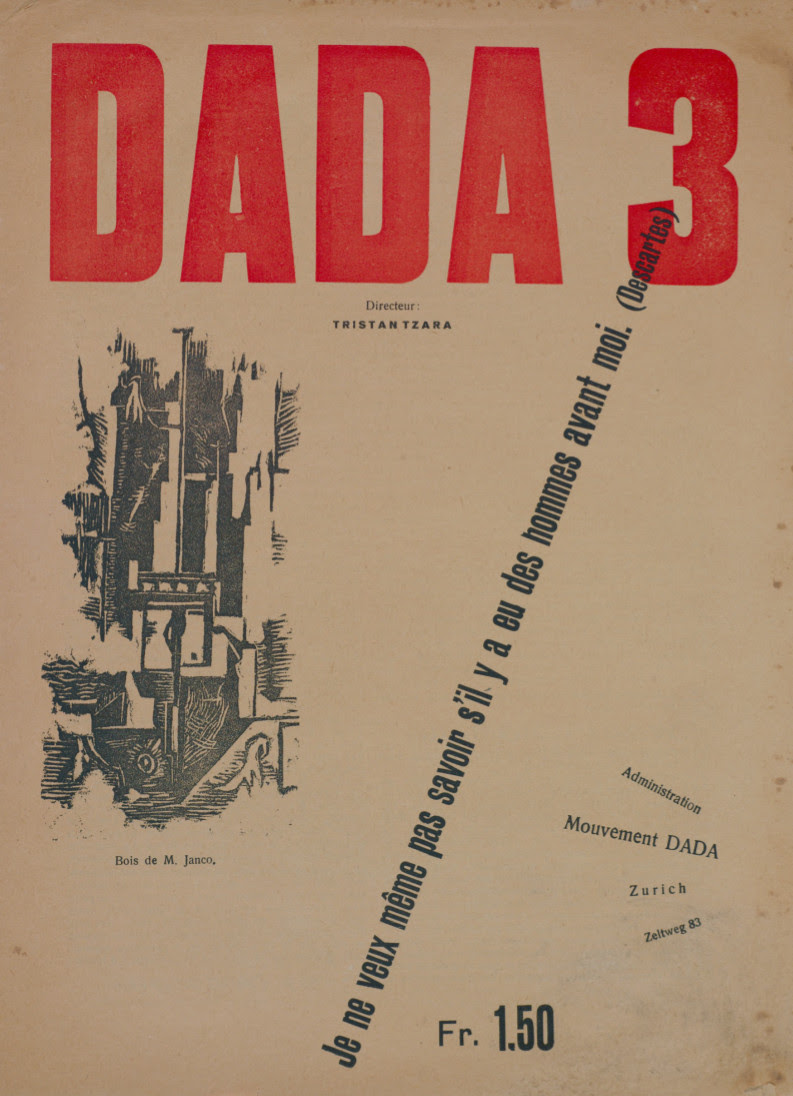 Edited by Tzara and including his manifesto in issue 3, the magazine “served to distinguish and define Dada in the many cities it infiltrated,” writes the Art Institute of Chicago, “and allowed its major figures to assert their power and position.” Dada succeeded a previous attempt by Ball at a journal called Cabaret Voltaire—named for his Zurich theater—which survived for one issue in 1917 before folding, along with the first version of the cabaret. That year, Tzara, “an ambitious and skilled promoter… began a relentless campaign to spread the ideas of Dada…. As Dada gained momentum, Tzara took on the role of a prophet by bombarding French and Italian artists and writers with letters about Dada’s activities.” Whatever Dada was, it wasn’t shy about promoting itself.  The first issue (cover at the top), contained commentary and poetry in French and Italian, and artwork like that above by important Romanian Dada artist, architect, and theorist Marcel Janco. Issues 4 and 5 were published together as an anthology, then World War I ended, and with travel again possible, Tzara, several Dada compatriots, and the journal moved to Paris. The final issue, Number 8, appeared in a truncated form. You can download each issue as a PDF from Monoskop or from Princeton University’s Blue Mountain Project, which also has an online viewer that allows you to preview each page before downloading.  Ball and Tzara were not the only assertive disseminators of Dada’s art and aims. The Art Institute of Chicago notes that in Berlin a “highly aggressive and politically involved Dada group” published its own short-lived journal, Der Dada, from 1919-1920.Download all three issues of that publication from the University of Iowa here. Related Content: Dada Was Born 100 Years Ago: Celebrate the Avant-Garde Movement Launched by Hugo Ball on July 14, 1916 Hear the Experimental Music of the Dada Movement: Avant-Garde Sounds from a Century Ago Extensive Archive of Avant-Garde & Modernist Magazines (1890-1939) Now Available Online Download 336 Issues of the Avant-Garde Magazine The Storm (1910-1932), Featuring the Work of Kandinsky, Klee, Moholy-Nagy & More Josh Jones is a writer and musician based in Durham, NC. Follow him at @jdmagness Download All 8 Issues of Dada, the Arts Journal That Publicized the Avant-Garde Movement a Century Ago (1917-21) is a post from: Open Culture. Follow us on Facebook, Twitter, and Google Plus, or get our Daily Email. And don't miss our big collections ofFree Online Courses, Free Online Movies, Free eBooks, Free Audio Books, Free Foreign Language Lessons, and MOOCs. |
|
Posted: 12 Jul 2016 01:00 AM PDT
For fans of what came to be called “alternative music,” the discovery of new artists and bands felt like a genuine adventure before the internet irrevocably changed music consumption. A few official venues acted as guides—magazines like Trouser Press andNME, shows like 120 Minutes, MTV’s late-night showcase of post-punk, new wave, industrial, etc. Word of mouth, local zines, college radio, mixtape gifts, and the purloined contents of older brothers and sisters’ record collections went a long way. Many of us had access to independent record stores that stocked all sorts of underground oddities, often run by obsessive know-it-alls like High Fidelity’s Rob Gordon. Venturing into that world could be an intimidating experience. But one dependable marker of quality hardly ever let young seekers down: the name of BBC DJ and curator extraordinaire John Peel. Peel’s influence on the musical trends of the last forty years is incalculable, and impossible to summarize in brief. (Learn about his legacy at this BBC tribute page.) From 1967 to his death in 2004, he recorded up and coming and underground bands in intimate sessions at BBC studios, and many of these classic recordings came out on his Strange Fruit label. No matter the band, no matter the genre, the mysterious gray cover of a Peel Sessions release always promised something worth forking over one’s hard-earned lawnmowing money to hear. Peel broadcast and recorded Nirvana before “Smells Like Teen Spirit” hit the mainstream; introduced his listeners to now-legends like Joy Division, The Smiths, and The Specials; gave Bowie his first break before his Ziggy Stardust fame; and played Bob Marley before Catch a Fire made him world famous.
These sessions and many more have been lovingly compiled in one Spotify playlist by Sebastien Vanblaere. If you have nostalgic memories of putting on a Peel Sessions record or cassette and having your mind blown by music the likes of which you’d never heard before, you may find your favorites here. My personal touchstone is Siouxsie and the Banshees’ Peel Session recordings, which to this day I prefer to their still excellent studio releases (hear “Love in a Void” at the top). Something about the way those focused live sessions were recorded, and the immediacy of their raw, uncluttered mixes, make them feel very personal, like a concert in your living room.
While I associate Peel’s name mainly with the post-punk niche of my youth, his eclectic tastes spanned the gamut. Before he gave the Ramones, The Damned, and other punk bands their first major play in the mid-seventies, Peel championed the psychedelic spacerock of Pink Floyd, the droning krautrock of Neu!, and the uncategorizable weirdness of Captain Beefheart; “he was among the first (and only) DJs anywhere,” writes the Houston Press, “to broadcast reggae, punk, hardcore, grindcore, grime and dubstep music over the radio.” Peel’s relevance never waned because his interest in finding, broadcasting, and recording new music never did either, but the playlist here mostly represents his pre-1990 favs, and sticks closely to rock, punk, new wave, and folk. See this page for a full listing of every John Peel session, from 1967 to three posthumous releases in 2004. And for a sense of the incredible breadth and eclectic inclusiveness of Peel’s musical tastes, visit the John Peel Archive, an online project cataloguing every single record in Peel’s collection. They’re currently up to 2679 of over 100,000 records total. Related Content: The 120 Minutes Archive Compiles Clips & Playlists from 956 Episodes of MTV’s Alternative Music Show (1986-2013) Revisit the Radio Sessions and Record Collection of Groundbreaking BBC DJ John Peel Prof. Iggy Pop Delivers the BBC’s 2014 John Peel Lecture on “Free Music in a Capitalist Society” Josh Jones is a writer and musician based in Durham, NC. Follow him at @jdmagness Stream 15 Hours of the John Peel Sessions: 255 Tracks by Syd Barrett, David Bowie, Siouxsie and the Banshees & Other Artists is a post from: Open Culture. Follow us on Facebook, Twitter, and Google Plus, or get our Daily Email. And don't miss our big collections of Free Online Courses, Free Online Movies, Free eBooks, Free Audio Books, Free Foreign Language Lessons, andMOOCs. |
|
Posted: 11 Jul 2016 03:58 PM PDT
 If you listen to the conspiracy theorists, they’ll tell you that Stanley Kubrick helped fake the Apollo 11 moon landing mission in 1969. Remember the vintage moon landing footage you’ve seen? Kubrick apparently shot the breathtaking video on a sound stage in Huntsville, Alabama, drawing on the special effects he perfected while shooting 2001: A Space Odyssey (1968). That’s how they explain that artifact. I wonder how they deal with this?: On Github, you can now download the source code forApollo 11’s command and lunar modules. Originally written by programmers at the MIT Instrumentation Laboratory in the mid-1960s, the code, according to Quartz, was recently put online by NASA intern Chris Garry, making it freely available to the coding community. You can find it all here and start hacking your way through the reams of obscure, vintage code. Skeptics can put their theories in the comments section below. via Quartz Related Content Michio Kaku & Noam Chomsky School Moon Landing and 9/11 Conspiracy Theorists 8,400 Stunning High-Res Photos From the Apollo Moon Missions Are Now Online Stanley Kubrick Faked the Apollo 11 Moon Landing in 1969, Or So the Conspiracy Theory Goes Free Online Computer Science Courses The Source Code for the Apollo 11 Moon Landing Mission Is Now Free on Github is a post from: Open Culture. Follow us onFacebook, Twitter, and Google Plus, or get our Daily Email. And don't miss our big collections of Free Online Courses, Free Online Movies, Free eBooks, Free Audio Books, Free Foreign Language Lessons, and MOOCs. |
|
Posted: 11 Jul 2016 10:50 AM PDT
In 1965, the editor of The Nation asked Hunter S. Thompson to write a story about the Hell’s Angels Motorcycle Club, as they’re officially known. The assignment eventually yielded the article, “The Motorcycle Gangs” (read it online), which became the basis for the 1966 book, Hell’s Angels: A Strange and Terrible Saga. It was Thompson’s first book, and America’s first real introduction to Thompson’s Gonzo-style journalism. Reviewing the book for The New York Times, Leo Litwak wrote: Hunter Thompson entered this terra incognita [the world of the Hell’s Angels] to become its cartographer. For almost a year, he accompanied the Hell’s Angels on their rallies. He drank at their bars, exchanged home visits, recorded their brutalities, viewed their sexual caprices, became converted to their motorcycle mystique, and was so intrigued, as he puts it, that “I was no longer sure whether I was doing research on the Hell’s Angels or being slowly absorbed by them.” At the conclusion of his year’s tenure the ambiguity of his position was ended when a group of Angels knocked him to the ground and stomped him…This clip above, which aired on Canadian television in 1967, describes the circumstances that led to the Angels giving HST a beat down. The misogyny that’s on display as the biker tells the story will make you shudder. Even worse are the laughs from the 1960s, buttoned-down crowd. As for whether the Angels ever got their two kegs of beer, I don’t know. Note: You can download Thompson’s Hell’s Angels: A Strange and Terrible Saga as a free audiobook if you sign up for a 30-Day Free Trial with Audible. Find more information on that program here. Related Content Read 18 Lost Stories From Hunter S. Thompson’s Forgotten Stint As a Foreign Correspondent Read 11 Free Articles by Hunter S. Thompson That Span His Gonzo Journalist Career (1965-2005) Free Online: Hunter S. Thompson’s Fear and Loathing in Las Vegas Read Hunter S. Thompson’s Fear and Loathing in Las Vegas, as It Was Originally Published in Rolling Stone Hunter S. Thompson Gets Confronted by The Hell’s Angels: Where’s Our Two Kegs of Beer? (1967) is a post from: Open Culture. Follow us on Facebook, Twitter, and Google Plus, or get our Daily Email. And don't miss our big collections of Free Online Courses,Free Online Movies, Free eBooks, Free Audio Books, Free Foreign Language Lessons, and MOOCs. |
|
Posted: 11 Jul 2016 08:26 AM PDT
Street art is a frequently dangerous game. The threat of arrest pales in comparison to some of the hazards long time practitioners describe. While other artists sketch in pleasant cafes, creators of large-scale street pieces often have no choice but to wriggle through ragged holes in chain link fences and climb to vertiginous heights to get to their canvases.
There’s a popular conception of graffiti artist as lone wolf, but when it comes to the perils of the street, there’s safety in numbers. You need a crew. Female street artists must draw on the power of sisterhood. As photojournalist Martha Cooper notes in the trailer for director Alexandra Henry’s Street Heroines, above:
I think bringing women together empowers them and there’s been some resistance on the part of men…it has to do with camaraderie too. It’s not that they’re saying, “You can’t do it,” but they’re just not allowing them in to their inner group.
Apparently, street art is something of an old boy’s club.“What!?” gasps Lady Pink, a well known veteran with over 35 years’ experience. “You need a penis to climb a ladder? Does it help you hold on?” The female camaraderie Cooper cites extends to the successful funding of a Kickstarter campaign to complete this documentary on “the courage and creativity of female graffiti & street artists from around the world.” As the deadline loomed, Lexi Bella & Danielle Mastrion, two of the women featured in the documentary, issued an open invitation to New York City-based female artists to join them in creating a spur-of-the-moment mural in Brooklyn, surrendering artistic control to embrace community spirit.  Many of the 25 artists Henry has profiled thus far speak of using their work to bring beauty to the street, and to advocate on behalf of the oppressed. Such earnestness may diminish them even further in the eyes of the old school He Man Woman Haters Club. Lexi Bella counterbalances the laughably soft image certain macho practitioners may assign to them by speaking unapologetically of the thrill of making one’s work as big as possible “so millions of people can see it.” Street Heroines is aiming for release in 2017. via The Creators Project Related Content: Google Puts Online 10,000 Works of Street Art from Across the Globe The Battle for LA’s Murals The Odd Couple: Jean-Michel Basquiat and Andy Warhol, 1986 Ayun Halliday is an author, illustrator, and Chief Primatologist of the East Village Inky zine. Follow her @AyunHalliday The Creativity of Female Graffiti & Street Artists Will Be Celebrated in Street Heroines, a New Documentary is a post from: Open Culture. Follow us on Facebook, Twitter, and Google Plus, or get our Daily Email. And don't miss our big collections of Free Online Courses, Free Online Movies, Free eBooks, Free Audio Books, Free Foreign Language Lessons, and MOOCs. |
| You are subscribed to email updates from Open Culture. To stop receiving these emails, you may unsubscribe now. | Email delivery powered by Google |
| Google Inc., 1600 Amphitheatre Parkway, Mountain View, CA 94043, United States | |
Etiquetas:
DADA,
MANIFESTES,
REVISTA
Suscribirse a:
Entradas (Atom)



















































